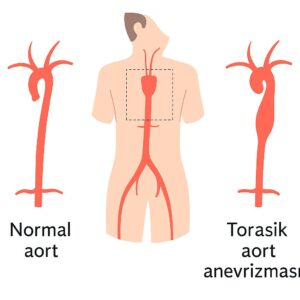A thoracic aortic aneurysm is a dilation that occurs in the part of the aorta within the chest cavity. This silent disease, which usually progresses without symptoms, can have fatal consequences when the vessel diameter reaches a critical level. This article will discuss in detail the definition, causes, symptoms, diagnosis, and current treatment methods of thoracic aortic aneurysm.

Where is the Thoracic Aorta?
The aorta is the main artery that exits the heart, passes through the chest cavity, and reaches the abdominal region. This long vascular structure is divided into three main regions:
1. Ascending aorta
2. Aortic arch
3. Thoracic aorta (descending part within the chest)
The thoracic aorta is the segment within the chest that begins after the arch and extends to the diaphragm. When an aneurysm forms in this area, it is called a “thoracic aortic aneurysm“.
What Causes Thoracic Aortic Aneurysm?
Several factors can play a role in the formation of these types of aneurysms. The most common causes are:
- Hypertension (high blood pressure): Continuous pressure on the aortic wall causes weakening over time.
- Atherosclerosis: Hardening of the arteries causes the vessel wall to lose its elasticity.
- Connective tissue disorders: Genetic conditions such as Marfan syndrome and Ehlers-Danlos syndrome disrupt the structural integrity of the vessel wall.
- Aortic dissection: A previous tearing event can lead to aneurysm development in this area.
- Advanced age and male gender: More common in men over 65 years of age.
What Are the Symptoms?
Thoracic aortic aneurysms are often asymptomatic. However, when the dilation reaches significant proportions, it can cause pressure on surrounding tissues, leading to the following complaints:
- Chest or back pain
- Shortness of breath
- Cough or hoarseness (pressure on vocal cords)
- Difficulty swallowing (pressure on esophagus)
- Coughing up blood (rarely, if close to airways)
If these symptoms appear, seek medical attention immediately.
How Is It Diagnosed?
The diagnosis of thoracic aortic aneurysm is usually made during imaging performed for another reason. The following methods are used for diagnosis:
- Computed Tomography (CT) Angiography: Clearly shows the diameter of the aorta, shape abnormalities, and relationship with surrounding organs.
- Magnetic Resonance (MR) Angiography: This radiation-free method is preferred especially in young patients or those with kidney disease.
- Transthoracic or transesophageal echocardiography: Used to evaluate the aorta exiting the heart and nearby segments.
What are the Treatment Methods?
The choice of treatment is determined based on the aneurysm’s diameter, the patient’s age, and general health condition. Two main methods stand out:
1. Open Surgery
- The chest cavity is opened.
- The aneurysmal vessel section is removed.
- An artificial vessel (graft) is sutured in its place.
- Heart-lung machine use is required.
This method is generally preferred for patients who are young, in good general health, and have suitable anatomy. However, the recovery time and risk of complications are higher.
2. Endovascular Method (TEVAR)
Thoracic Endovascular Aortic Repair (TEVAR) is a minimally invasive approach:
- A stent-graft is placed inside the vessel entering through the groin area.
- The aneurysm is closed from the inside, thus eliminating the risk of rupture.
Advantages:
- Hospital stay is shorter (1-3 days).
- Risks such as infection and blood loss are lower.
However, this method is not suitable for every patient. The shape, length of the vessel, and areas where the stent will adhere must be carefully analyzed.
Follow-up and Risk Management
The risk of rupture in thoracic aortic aneurysms increases when the diameter reaches 5.5-6 cm. This threshold is lower in patients with a history of dissection or rapidly growing aneurysms.
Follow-up recommendations:
- CT or MR angiography every 6-12 months
- Blood pressure control (ideal to keep it below 120/80 mmHg)
- Smoking should be quit and cholesterol should be balanced
- Regular doctor check-ups should not be neglected
Thoracic aortic aneurysm is a disease that can be effectively treated when diagnosed early. Due to its silent progression, it is especially important for individuals in the risk group to have regular check-ups. Thanks to advancing surgical and endovascular techniques, patients can now recover their health in a shorter time with less invasive methods.
If you’d like, I can convert this to HTML format or make it visually compatible. Would you like me to help?
